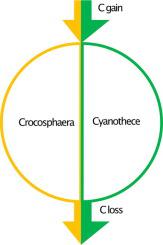Computational and Structural Biotechnology Journal ( IF 6 ) Pub Date : 2022-11-17 , DOI: 10.1016/j.csbj.2022.11.029 Takako Masuda 1 , Keisuke Inomura 2 , Meng Gao 2 , Gabrielle Armin 2 , Eva Kotabová 1 , Gábor Bernát 1, 3 , Evelyn Lawrenz-Kendrick 1 , Martin Lukeš 1 , Martina Bečková 1 , Gábor Steinbach 1, 4 , Josef Komenda 1 , Ondřej Prášil 1

|
Crocosphaera and Cyanothece are both unicellular, nitrogen-fixing cyanobacteria that prefer different environments. Whereas Crocosphaera mainly lives in nutrient-deplete, open oceans, Cyanothece is more common in coastal, nutrient-rich regions. Despite their physiological similarities, the factors separating their niches remain elusive. Here we performed physiological experiments on clone cultures and expand upon a simple ecological model to show that their different niches can be sufficiently explained by the observed differences in their photosynthetic capacities and rates of carbon (C) consumption. Our experiments revealed that Cyanothece has overall higher photosynthesis and respiration rates than Crocosphaera. A simple growth model of these microorganisms suggests that C storage and consumption are previously under-appreciated factors when evaluating the occupation of niches by different marine nitrogen fixers.
中文翻译:

光合作用和呼吸之间的平衡解释了 Crocosphaera 和 Cyanothece 之间的生态位分化
Crocosphaera和Cyanothece都是单细胞固氮蓝藻,它们喜欢不同的环境。Crocosphaera主要生活在营养耗尽的开阔海洋中,而 Cyanothece则更常见于沿海、营养丰富的地区。尽管它们在生理上有相似之处,但区分它们的生态位的因素仍然难以捉摸。在这里,我们对克隆培养物进行了生理学实验,并扩展了一个简单的生态模型,以表明它们的不同生态位可以通过观察到的光合能力和碳 (C) 消耗率的差异来充分解释。我们的实验表明,Cyanothece的光合作用和呼吸速率总体上高于鳄鱼目。这些微生物的简单生长模型表明,在评估不同海洋固氮生物对生态位的占用时,碳储存和消耗是以前被低估的因素。


























 京公网安备 11010802027423号
京公网安备 11010802027423号